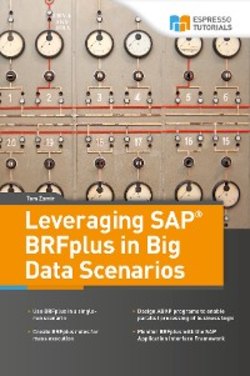Читать книгу Leveraging SAP BRFplus in Big Data Scenarios - Tom Zamir - Страница 8
На сайте Литреса книга снята с продажи.
1.1.2 Mind your own business
ОглавлениеThe purpose of business rules (computerized or otherwise) is to help the company or organization conduct its business. More specifically, the aim of using business rules is to avoid errors or mistakes whilst increasing efficiency by providing swift answers to specific questions such as: What is the meaning of this term? Is this allowed? What should I do next? The business efficiency may be measured differently in different businesses and for different situations—for example: low cost of production, average speed of manufacturing, number of faulty units per batch, etc. The nature of the business is irrelevant; every business relies on rules. If a business were to be founded without rules whatsoever, then it would soon disintegrate as every employee and every machine would behave in a completely unexpected manner.
Business rule = Instantaneous correct answer
A good rule is one that leaves no room for doubt; for a specific context and a specific decision to be made, a specific definitive directive is returned. The benefit is two-fold: improved reaction time to the situation by providing an instant course of action, and one that is presumably preferable to other inappropriate or risky alternatives.
Many rules are the result of tough lessons that were learned in the past and thus represent the allegedly canonical safer and/or better way of doing things. I use the word “allegedly” here because if a business rule is too old, then it might be outdated in the sense that the conditions that helped fashion it in the first place are no longer valid. In this case, the rule may cause more harm than good. Also, too many rules can lead to a counterproductive environment (overwhelming bureaucracy).
Business rule = Tactical means of supporting a strategy
A business rule is a matter of organizational policy that may change over the course of time. Now more than ever before, companies and corporations have to pay attention to their business rules and make sure they are up to date—as rapidly advancing technologies shrink distances and minimize time-to-market, enabling competition to react fast and from far away. To remain competent, the business rules must be aligned with the organization’s overall strategy, which may change from time to time. Every rule should be considered as a tactical means of supporting this strategy to achieve the organization’s ultimate goals. As a tactical means, computerized business rules should be flexible and easy to maintain. It is preferable for business users to be empowered to manage their own business rules (rather than having rules imposed on them by IT personnel who may be slightly removed from the field of action).
Consider the goal (one of many) of a country, as an organization, to uphold common order and stability on the roads. Its strategy is to enforce order by means of electronic devices for regulating traffic, namely traffic light systems. Can the law that states that crossing an intersection on a red light is illegal be considered a business rule? If we phrase this law as the logic shown below, then it must be considered a business rule that helps translate the light signals into human language:
If light is red, approach slowly until you come to a complete stop.
Else if yellow, approach with care.
Else if green, drive normally.
However, the traffic regulation itself is achieved (at a tactical level) via the specific logic used to operate the traffic light system (e.g., the overall duration of the cycle in seconds, the interdependency of the different traffic lights, etc.). The rules that define the logic of the traffic light system at each intersection are the key business rules that help achieve the goal in this example.
In this context, we can imagine certain circumstances where updating those traffic light rules would be desirable. For instance, when the surroundings of a certain intersection have changed, for example a successful shopping center has been erected or a new roadway has been laid—these changes could divert extra traffic to or from the intersection and would cause the current configurations to be suboptimal.
